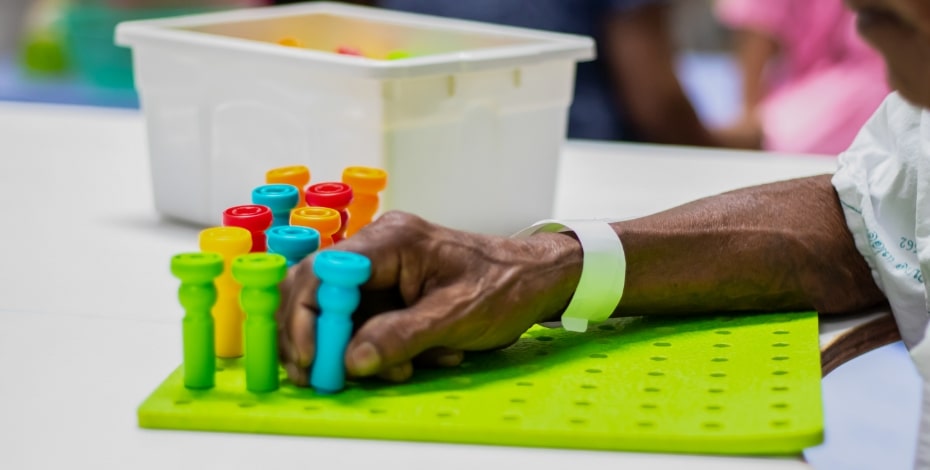
Stronger upper limbs after stroke with CIMT

Ashan Weerakkody’s new course explores the significant benefits of constraint-induced movement therapy for upper limb rehabilitation in stroke patients.
Tell us a bit about the course. Who would benefit most from attending ‘Upper limb constraint-induced movement therapy (CIMT)’?
There is strong evidence supporting the use of constraint-induced movement therapy (CIMT) to improve upper limb function after stroke, suggesting that we as clinicians should be providing it to our patients.
However, CIMT is a complex intervention to deliver and not a lot is taught about it in undergraduate physiotherapy courses.
This two-day course will provide a complete overview of the evidence underpinning CIMT, clear descriptions of its components and practical learning to apply each of these components as part of the overall CIMT package.
The course delivery combines theory-based presentations, practical sessions and group discussions to assist participants to translate the learning from this course into their own clinical settings.
The majority of CIMT research has focused on stroke, which will be a focus of this course too.
However, the course will also touch on the evidence for and application of CIMT for other neurological conditions, such as traumatic brain injury and multiple sclerosis.
The development of this course is the result of implementing CIMT over the past four years within a rehabilitation service of over 100 physiotherapists, occupational therapists and allied health assistants.
This included learning how to adapt a CIMT program to suit a local context and supporting clinicians working in inpatient, outpatient and community-based rehabilitation services to deliver CIMT programs in their practice settings.
This course is best suited to physiotherapists who are currently or have experience working with neurological patients and providing upper limb rehabilitation.
Why is constraint-induced movement therapy effective at all time points after stroke?
Throughout the stroke recovery continuum, a key factor for driving neuroplasticity is high intensity, repetitive use of the impaired upper limb that is sufficiently challenging for improving motor function and skill acquisition, but also meaningful to the patient.
We need patients to buy in and take ownership of their rehabilitation in order to engage in an intensive program, which we as clinicians have a major role in driving and supporting.

Ashan Weerakkody's research focuses on the implementation of constraint-induced movement therapy.
CIMT neatly packages these principles into a structured program.
Patients are engaged and motivated to participate, therapy is individualised and targeted to their impairments and tools are utilised to translate the gains made during therapy into functional use in the real world.
What are the barriers to providing CIMT in clinical practice and how can these be overcome?
As physiotherapists, we pride ourselves on providing evidence-based rehabilitation practice.
CIMT is strongly supported in the literature, yet its provision remains limited and I don’t think it’s because clinicians are dismissing the evidence.
Substantial research has been conducted to investigate barriers to clinicians providing CIMT.
Overwhelmingly, physiotherapists and occupational therapists report that they lack the knowledge, skills and confidence to deliver a CIMT program.
Many also reported time constraints or that providing CIMT wouldn’t be feasible in their clinical setting.
Interestingly, these barriers are reported less among those experienced in providing CIMT, suggesting that this may be more of a perception than the experience.
The evidence tells us that clinicians who have attended a formal CIMT course are more likely to provide it in their practice, hence the development of this course to encourage more clinicians to provide this gold-standard therapy.
What are participants likely to take away with them for use in everyday practice?
Most importantly, participants will learn that there is so much more to CIMT than just popping a mitt on a patient’s ‘good’ arm.
The course will help participants understand and address the barriers and enablers to providing CIMT within their own setting and they should come away with an idea of a CIMT program that would work best for their patients.
Participants will learn how to identify which patients are suitable for CIMT and more likely to have a successful program (for example, patients who are already motivated, who have minimal or no cognitive impairment and who have good active movement of the hand) and how to encourage participation and deliver a program in its entirety.
It should be noted that providing CIMT to patients is a skill that develops with experience and practice—even very experienced clinicians have taken programs to increase their confidence when trying CIMT with more complex patients (such as those with greater upper limb impairment, shoulder pain, aphasia or some cognitive impairment).
This course will lay the foundations for participants to confidently deliver CIMT as part of their practice.
‘Upper limb constraint-induced movement therapy (CIMT)’ will run from Saturday 30 April to Sunday 1 May, 9 am – 5 pm, in Bentley, Western Australia. Click here for more information and to register.
>> Ashan Weerakkody, MACP, is an APA Neurological Physiotherapist and a senior physiotherapist in neurology/stroke. He co-developed the implementation of constraint-induced movement therapy across a large early supported discharge rehabilitation service, increasing the uptake of this therapy among physiotherapists, occupational therapists and allied health assistants. This implementation has been the focus of his research.
© Copyright 2025 by Australian Physiotherapy Association. All rights reserved.





